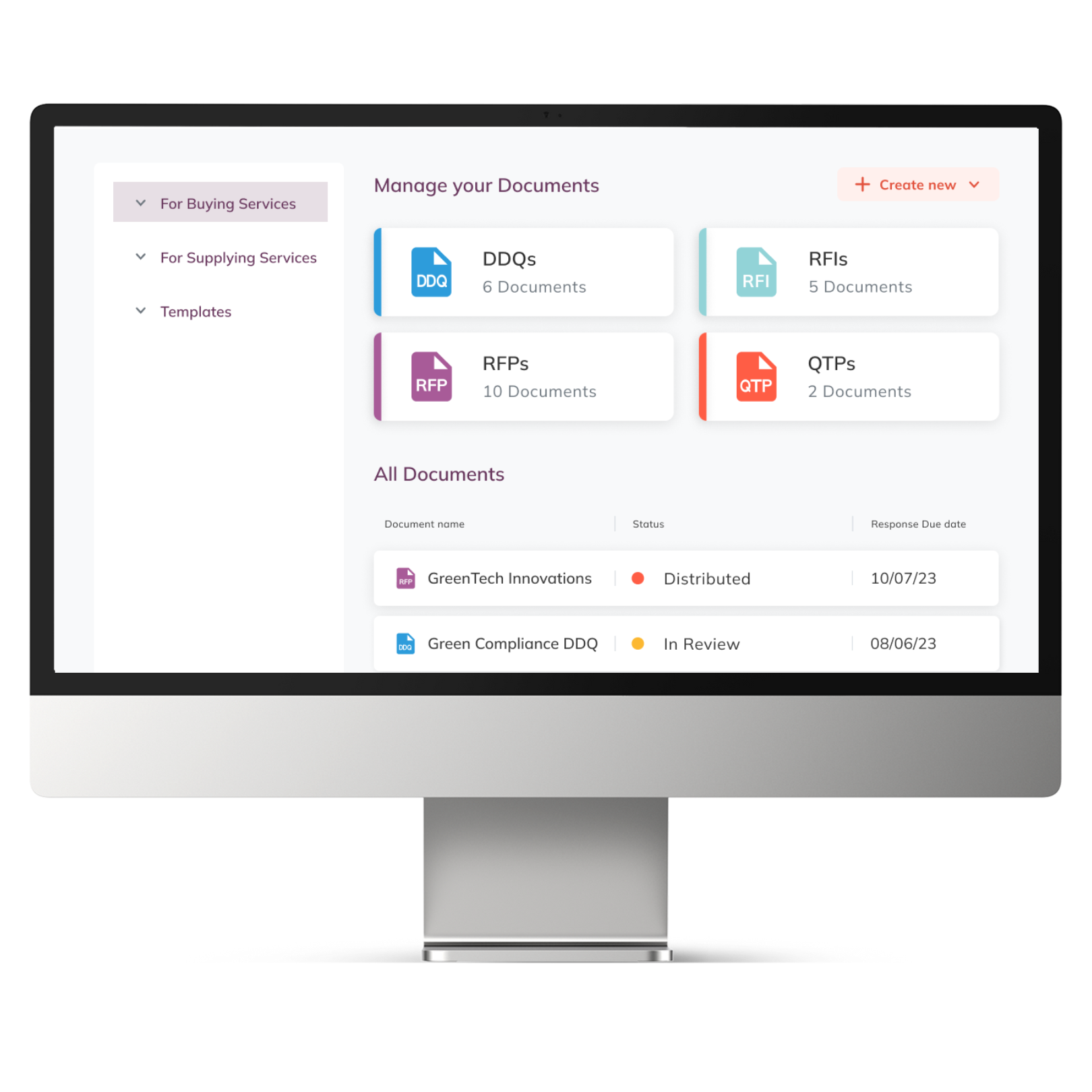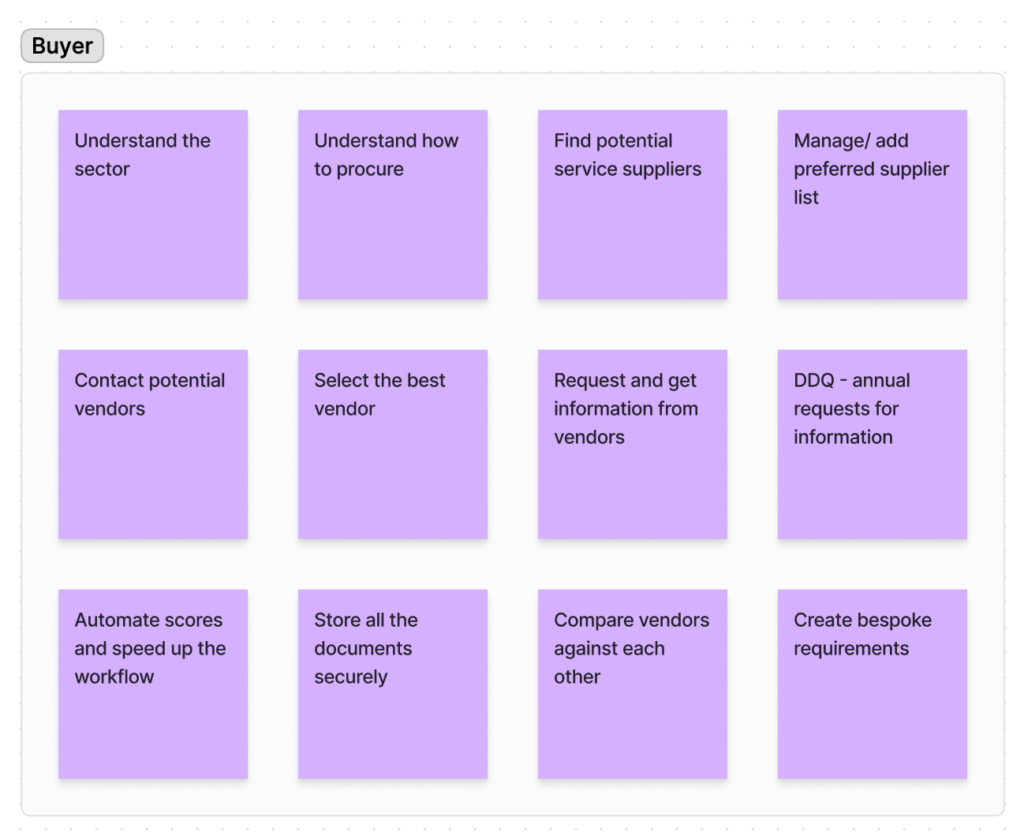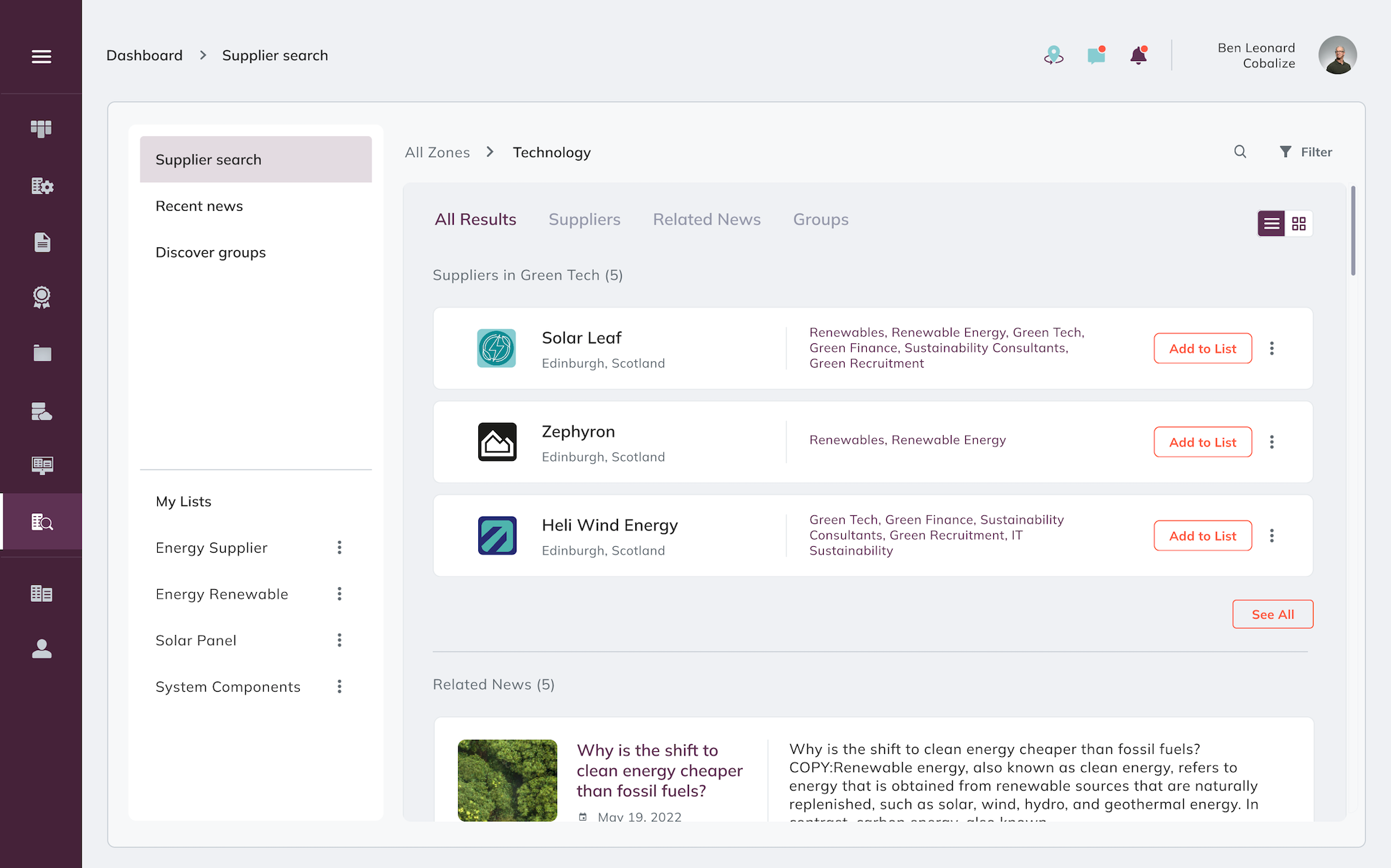
Procurement Solution
Cloud-based B2B procurement platform bolstering efficiency with automation and collaboration
project Overview
The project revolved around the development of a cloud-based platform using Microsoft Azure, intended to revolutionise the procurement process within B2B operations.
Centralisation, automation, and collaboration are cornerstones of this platform, aiming to bolster efficiency between buyers and suppliers.
The platform’s central concept is to eliminate the dependency on spreadsheets, thereby streamlining workflows and promoting a centralised workspace.
Project Exploration
Step away from the solution (for now) and let's define the problems first
Project exploration began with a deep dive into understanding the key stakeholders: the buyers and the vendors. The goal was to comprehend their jobs to be done (JTBD), motivations, challenges, and workflows.
For Procurement, what ‘jobs’ does a buyer need to get done?
Engaging in conversations and conducting surveys with a spectrum of procurement professionals gave valuable insights into their everyday responsibilities, challenges, and requirements.

For Procurement, what ‘jobs’ does a vendor need to get done?
In the same vein, we reached out to various vendors who frequently interact with procurement platforms.

Defining the Problem
By consolidating and analysing the shared challenges from both buyers and suppliers, key problems emerged that our platform aimed to solve:
1
Inefficient communication between buyers and suppliers
2
Laborious manual processes necessitating automation
3
Difficulty in managing and centralising procurement data
4
A pressing need for enhanced comparison, scoring, and reporting tools
Exploring different options
- how we could solve the users 'jobs'
With a clear understanding of the key problems to solve, I initiated the process of exploring different potential solutions. The aim was to address each problem and meet the user’s jobs more effectively.


Pulse Market Miro board
Competitive Analysis:
Aiming for the Edge
Understanding the competitive landscape is vital in carving out our niche and giving Pulse Market an edge. The goal was to analyse existing procurement solutions, identify their strengths and shortcomings, and leverage these insights to create a product that truly stands out.

Competitive Analysis
Dissecting the Procurement Software Space
A thorough review of leading procurement software platforms revealed a crucial gap: none offered Supplier Management, an essential aspect according to user surveys. The aim then was to integrate this into Pulse Market and deliver a comprehensive solution that serves users better than rival applications.
Diving into Supplier Management
The search for a market leader in Supplier Management required some refinement as the term initially led towards companies focusing on project management and product. Pivoting the research towards Vendor Risk Management (VRM) yielded more relevant results.
The competitive analysis has been instrumental in shaping Pulse Market. It not only guided me toward a much-needed functionality but also helped me understand our unique selling proposition, setting us apart from the competition.
Ideation and Concept Development
Having explored different options to address user needs, it was time to synthesize the findings and enter the ideation phase.
After brainstorming sessions, encouraging free thinking and promoting the sharing of even the most radical ideas. Key ideas were then combined and refined, and the most promising ones were developed into initial concepts.
These concepts, addressing the problems identified, were then transformed into low-fidelity wireframes.
Low-fidelity Wireframes
Having crystallized the ideas into viable concepts, I started to give them a tangible form through low-fidelity wireframes. These basic visual representations were instrumental in understanding the initial structure of the procurement platform.

User Journey diagram

RFX Flow – Buyer

RFX Response flow – vendor
Structure & Layout
The primary concern was the overall flow and placement of the platform’s elements. I designed wireframes for key pages, ensuring the layout was intuitive and user-friendly.
Navigation
I outlined a clear and efficient navigation system within our wireframes. Menus, dropdowns, and links were carefully planned and placed to facilitate easy movement around the platform.
User Interactions
Even at this early stage, I considered the user’s interactions with the platform. How would they initiate a new procurement process? How would they communicate with a supplier? How would they navigate to a document or report?
Embrace the Revolution
Say Goodbye to Spreadsheets!
High-fidelity Wireframes
After strategic iterations during the low-fi prototyping stage and refinement of wireframes, it was time to dive into the creation of mid and high-fidelity prototypes. These prototypes were brought to life with interactive elements using Figma, presenting a more accurate representation of the final product.

High-Fidelity flows in Figma
User Testing
No design process is complete without testing the solution with actual users. The aim was to validate the design decisions and to ensure that the platform met user needs and was easy to use.
A group of participants that represented our user base were selected. This included both procurement professionals (buyers) and suppliers who frequently interact with procurement platforms.
Each participant was given access to our high-fidelity prototypes and were asked to perform a series of tasks that reflected common use cases. These ranged from initiating a new procurement process, to comparing suppliers, and generating reports.
While the participants interacted with the platform, I observed their actions, noted their comments, and asked clarifying questions. We also used heatmaps and click-tracking for a more detailed analysis.
The results from our user tests were eye-opening. They revealed areas of the platform that worked well and others that needed improvement. I gathered all this feedback and used it to refine the platform further. Each round of testing brought us closer to a solution that truly met user needs.
Final Design and Launch
The Last Mile: Polishing and Propelling to Market
With insights from user testing in hand, I moved toward the final phase of the product design process. I refined the high-fidelity prototypes, making necessary adjustments based on user feedback. The final design was a harmonious blend of user needs, technical feasibility, and business goals.
Pre-launch Preparations
Before the official launch, I conducted a Beta release with a select group of users to ensure all aspects of the platform worked seamlessly. I then tweaked the platform as needed, resolving any remaining bugs and enhancing user experience elements.
The Launch
With excitement and anticipation, the cloud-based procurement platform was launched to the market. It was a moment of pride and accomplishment for the entire team. The platform was well-received, demonstrating promising potential to transform procurement processes for B2B operations.
Post-launch Evaluation and Improvements
The launch was only the beginning. I continue to monitor user feedback and platform performance post-launch. Iterative improvements and feature additions were planned in response to user needs and market trends. This ensures the procurement platform remains cutting-edge and user-centric.
Procurement Console
Accessible via the Menu or Dashboard, acts as a control center for all procurement activities.
Users can instantly create new RFPs, DDQs, RFIs, or QTPs with intuitive options. Ongoing activities are presented in a clear, color-coded layout, facilitating easy monitoring and management.
The console also features sections for response management and template customization, allowing users to handle received responses and modify document templates effectively.


Document editor
Users can add modules, questionnaires, and configure the type of questions. Further enhancing customisation, the editor allows pre-scoring, logic setting, and weight assignment, ensuring every document is perfectly tuned to the specific procurement needs.
RFX Distribution
Invitations to respond to RFXs can be sent effortlessly, either through email or directly to suppliers registered on the platform. This allows buyers to engage a wide network of suppliers, broadening their procurement reach.
In addition, the supplier search functionality helps buyers discover and connect with potential partners on the platform. From searching to sending invitations, every step is designed for optimal user convenience and procurement efficiency.


Responses
Users can leverage the ability to reuse previous answers, saving time and ensuring consistency across responses. The platform’s notification system keeps users updated on incoming responses or required actions.
Moreover, direct communication with buyers is enabled within the document, allowing users to seek further clarification, fostering transparency and collaboration in the procurement process.
Evaluating Responses & Requesting Clarifications
Buyers can add scores to suppliers’ responses, providing a clear and quantifiable measure of supplier suitability. For additional details or clarification, buyers can easily request further information directly through the platform.
This feature facilitates a detailed analysis of responses, ensuring a comprehensive and well-informed procurement decision-making process.


Comparison Mode: Side-by-Side Analysis
In this mode, buyers can view responses side-by-side, making it simple to compare and contrast suppliers’ offerings. This feature ensures that decision-making is informed by a clear, comprehensive comparison, aiding in the selection of the most suitable suppliers.
Supplier Management
Buyers can effortlessly track responses, contracts, and other essential communication with each supplier. Additionally, the feature allows for the uploading of relevant documents, creating a centralised repository for each supplier’s information.


Supplier Search
This feature optimises supplier discovery and management process. It facilitates a strategic exploration of supplier zones and allows for the application of custom filters, granting users a refined and targeted search. Additionally, the “watchlist” function offers a convenient method for shortlisting suppliers, expediting the process of document distribution.
UI Design
Visualising the Vision: From Mood Boards to UI
The journey to designing the visual interface of Pulse Market was an iterative process.I started with mood boards to capture the overall aesthetic we wanted to convey. The mood boards were a mix of colors, typography, and UI elements that encapsulated the feel of the platform.
The elements were assembled into a style guide – a comprehensive document that sets the visual standard for Pulse Market.
Design System: Evolution in Progress
As the product development of Pulse Market unfolded, the creation of a design system became essential.
The journey began with the standardization of frequently utilized components like buttons, form fields, icons, and color palettes. A comprehensive library was created to house these elements, establishing a go-to reference for design decisions.

Fields – Pulse Library in Figma
Next steps
Tracing Customer Journeys
To further improve and tailor the Pulse Market experience, it’s essential to delve deeper into the interactions our users have with the platform. One effective way to do this is through customer journey mapping.
The insights derived from these customer journeys will prove invaluable. They will allow us to refine and enhance Pulse Market, ensuring it continues to deliver a user-centric, effective, and enjoyable procurement experience.
Watch the demo
Discover the Journey: Experience the Demo
Experience the functionality and aesthetics of Pulse Market first-hand with a comprehensive demo I’ve built using Figma.
The demo brings to life the entire procurement process – from creating and distributing procurement documents to evaluating responses, and final selection.